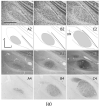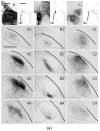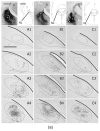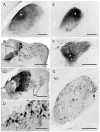Connections of the auditory brainstem in a songbird, Taeniopygia guttata. I. Projections of nucleus angularis and nucleus laminaris to the auditory torus
- PMID: 20394061
- PMCID: PMC3862038
- DOI: 10.1002/cne.22334
Connections of the auditory brainstem in a songbird, Taeniopygia guttata. I. Projections of nucleus angularis and nucleus laminaris to the auditory torus
Abstract
Auditory information is important for social and reproductive behaviors in birds generally, but is crucial for oscine species (songbirds), in particular because in these species auditory feedback ensures the learning and accurate maintenance of song. While there is considerable information on the auditory projections through the forebrain of songbirds, there is no information available for projections through the brainstem. At the latter levels the prevalent model of auditory processing in birds derives from an auditory specialist, the barn owl, which uses time and intensity parameters to compute the location of sounds in space, but whether the auditory brainstem of songbirds is similarly functionally organized is unknown. To examine the songbird auditory brainstem we charted the projections of the cochlear nuclei angularis (NA) and magnocellularis (NM) and the third-order nucleus laminaris (NL) in zebra finches using standard tract-tracing techniques. As in other avian species, the projections of NM were found to be confined to NL, and NL and NA provided the ascending projections. Here we report on differential projections of NA and NL to the torus semicircularis, known in birds as nucleus mesencephalicus lateralis, pars dorsalis (MLd), and in mammals as the central nucleus of the inferior colliculus (ICc). Unlike the case in nonsongbirds, the projections of NA and NL to MLd in the zebra finch showed substantial overlap, in agreement with the projections of the cochlear nuclei to the ICc in mammals. This organization could suggest that the "what" of auditory stimuli is as important as "where."
(c) 2010 Wiley-Liss, Inc.
Figures















Similar articles
-
Connections of the auditory brainstem in a songbird, Taeniopygia guttata. III. Projections of the superior olive and lateral lemniscal nuclei.J Comp Neurol. 2010 Jun 1;518(11):2149-67. doi: 10.1002/cne.22325. J Comp Neurol. 2010. PMID: 20394063 Free PMC article.
-
Connections of the auditory brainstem in a songbird, Taeniopygia guttata. II. Projections of nucleus angularis and nucleus laminaris to the superior olive and lateral lemniscal nuclei.J Comp Neurol. 2010 Jun 1;518(11):2135-48. doi: 10.1002/cne.22324. J Comp Neurol. 2010. PMID: 20394062 Free PMC article.
-
Subdivisions of the auditory midbrain (n. mesencephalicus lateralis, pars dorsalis) in zebra finches using calcium-binding protein immunocytochemistry.PLoS One. 2011;6(6):e20686. doi: 10.1371/journal.pone.0020686. Epub 2011 Jun 20. PLoS One. 2011. PMID: 21701681 Free PMC article.
-
Parallel auditory pathways: projection patterns of the different neuronal populations in the dorsal and ventral cochlear nuclei.Brain Res Bull. 2003 Jun 15;60(5-6):457-74. doi: 10.1016/s0361-9230(03)00050-9. Brain Res Bull. 2003. PMID: 12787867 Review.
-
Anatomophysiology of the central auditory nervous system: basic concepts.Acta Otorhinolaryngol Belg. 2003;57(4):227-36. Acta Otorhinolaryngol Belg. 2003. PMID: 14714940 Review.
Cited by
-
Auditory processing in the zebra finch midbrain: single unit responses and effect of rearing experience.PeerJ. 2020 Jul 24;8:e9363. doi: 10.7717/peerj.9363. eCollection 2020. PeerJ. 2020. PMID: 32775046 Free PMC article.
-
Estradiol-dependent modulation of auditory processing and selectivity in songbirds.Front Neuroendocrinol. 2011 Aug;32(3):287-302. doi: 10.1016/j.yfrne.2010.12.002. Epub 2010 Dec 10. Front Neuroendocrinol. 2011. PMID: 21146556 Free PMC article. Review.
-
Coevolution in communication senders and receivers: vocal behavior and auditory processing in multiple songbird species.Ann N Y Acad Sci. 2011 Apr;1225:155-65. doi: 10.1111/j.1749-6632.2011.05989.x. Ann N Y Acad Sci. 2011. PMID: 21535002 Free PMC article. Review.
-
Connections of the auditory brainstem in a songbird, Taeniopygia guttata. III. Projections of the superior olive and lateral lemniscal nuclei.J Comp Neurol. 2010 Jun 1;518(11):2149-67. doi: 10.1002/cne.22325. J Comp Neurol. 2010. PMID: 20394063 Free PMC article.
-
Distribution of calcium-binding proteins, parvalbumin and calbindin, in the midbrain auditory center (MLd) of a pigeon.Dokl Biol Sci. 2016;466:1-4. doi: 10.1134/S001249661601004X. Epub 2016 Mar 30. Dokl Biol Sci. 2016. PMID: 27021359
References
-
- Adolphs R. Acetylcholinesterase staining differentiates functionally distinct auditory pathways in the barn owl. J Comp Neurol. 1993;329:365–377. - PubMed
-
- Anderson LA, Malmierca MS, Wallace MN, Palmer AR. Evidence for a direct, short latency projection from the dorsal cochlear nucleus to the auditory thalamus in the guinea pig. Eur J Neurosci. 2006;24:491–498. - PubMed
-
- Anderson LA, Izquierdo MA, Antunes FM. A monosynaptic pathway from dorsal cochlear nucleus to auditory cortex in rat. Neuroreport. 2009;20:462–466. - PubMed
-
- Arends JJ. PhD Thesis. University of Leiden; Leiden, Netherlands: 1981. Sensory and motor aspects of the trigeminal system in the mallard (Anas Platyrhynchos L.)
Publication types
MeSH terms
Grants and funding
LinkOut - more resources
Full Text Sources
Research Materials
Miscellaneous

